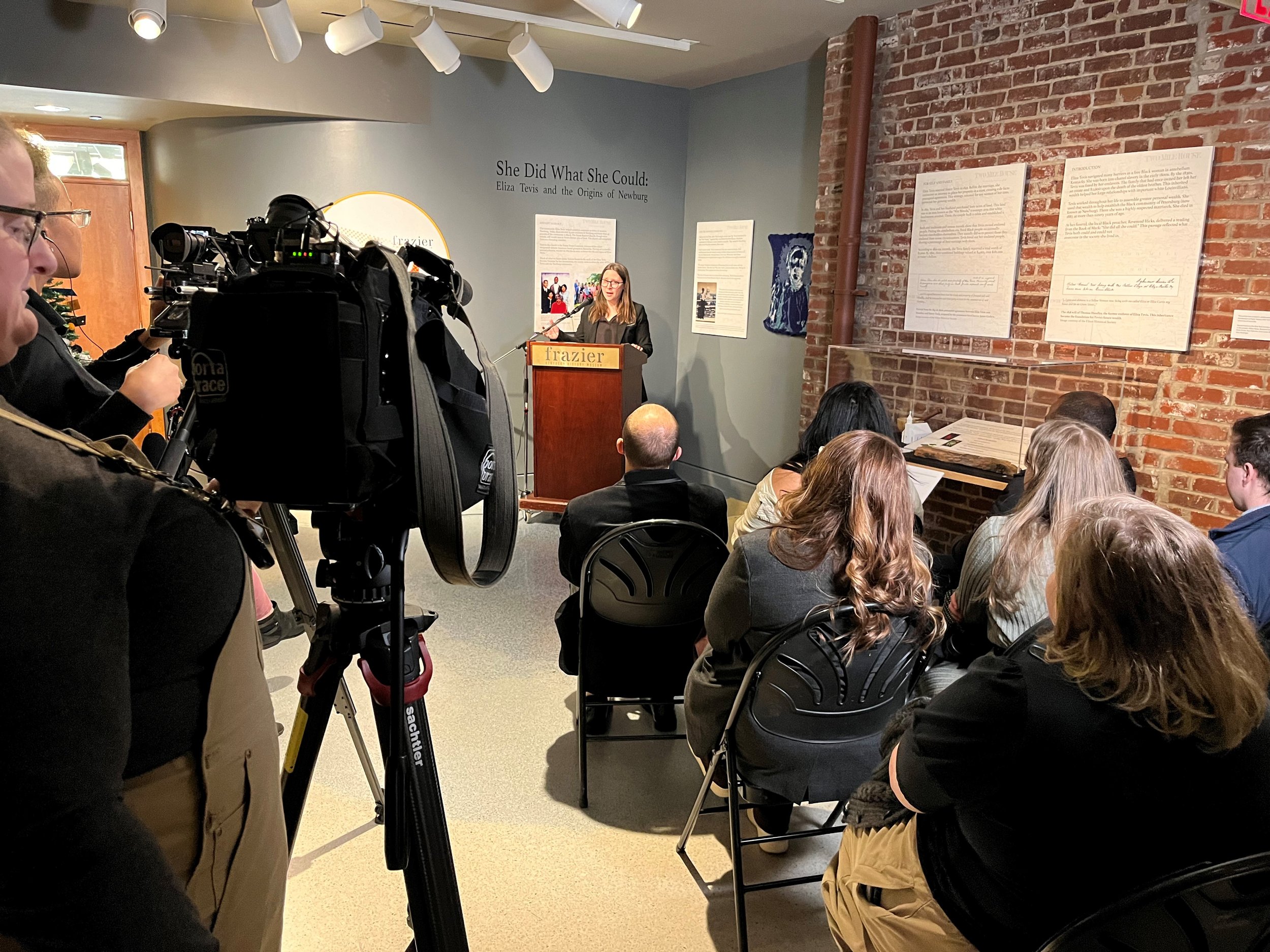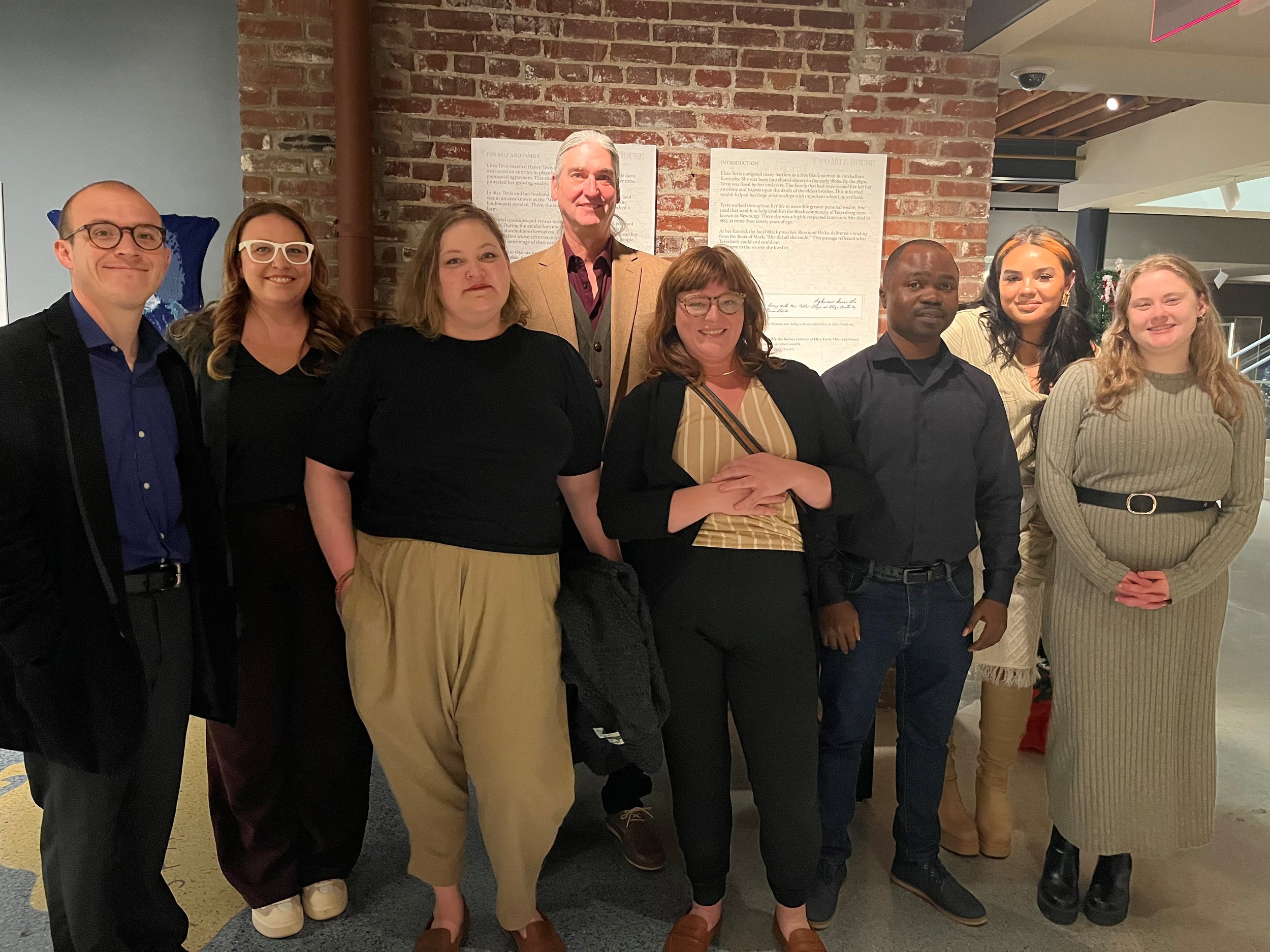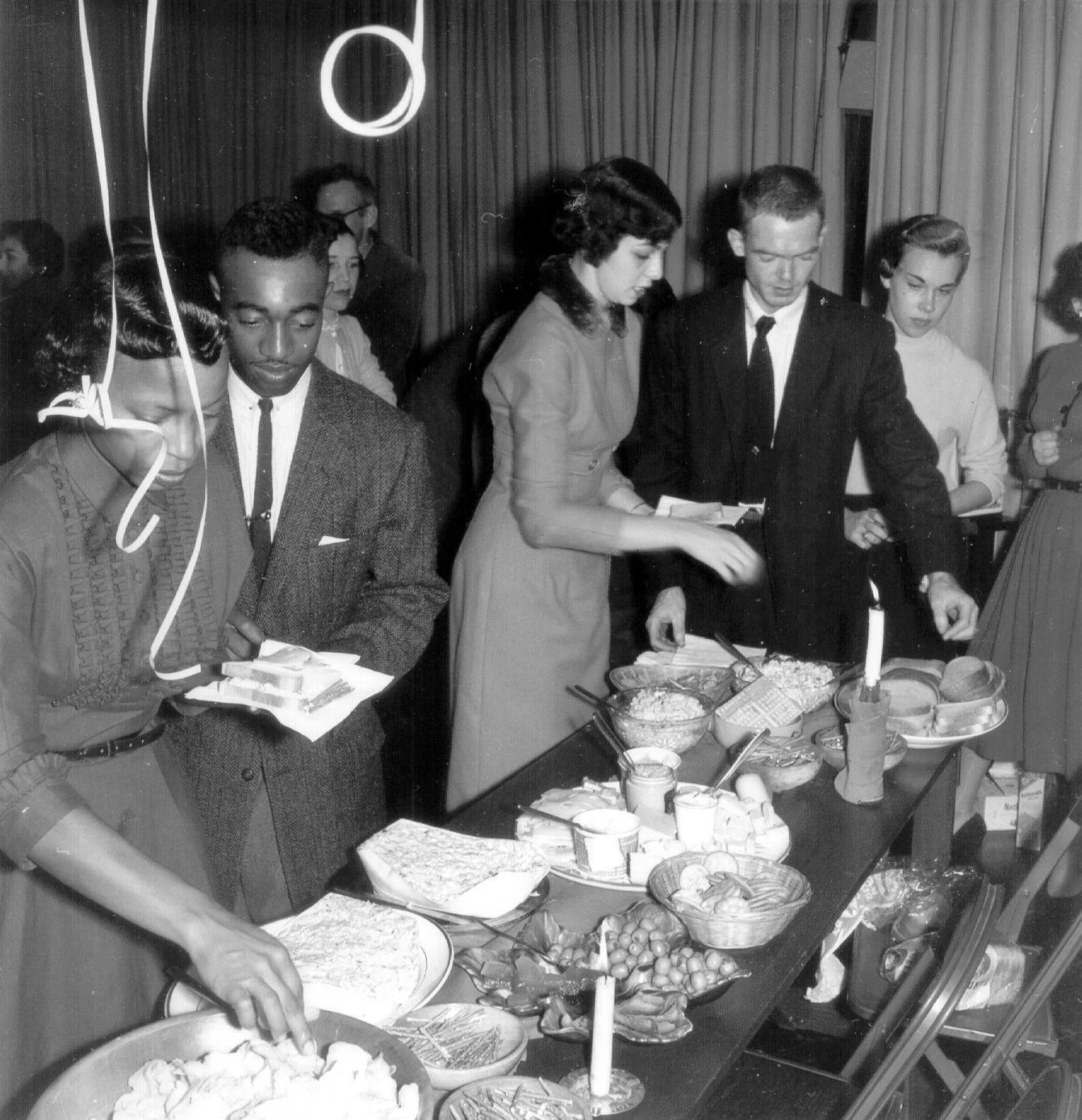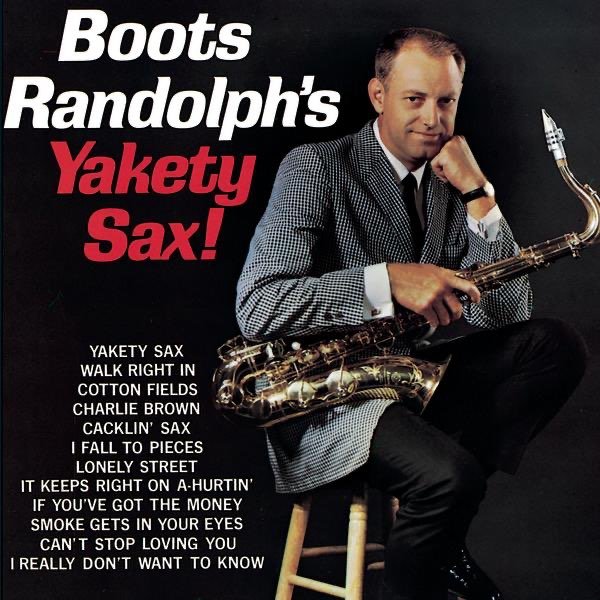Eliza Tevis Exhibit, Lights on Main’s Next Late Night Wednesday, Musical Kentucky: Trigg–Woodford, and More
What started as a conversation has grown into a wonderful partnership, a learning experience, and now a temporary mini-exhibit at the Frazier History Museum created and designed by students at the University of Louisville.
Talk about a win-win for us and U of L, but also for guests to our museum who will learn about Eliza Tevis and her connections to the Newburg neighborhood dating back to the 1830s.
Many of her descendants still live in Newburg and have established the Eliza Tevis Society. They were also crucial players in this collaboration at the Frazier.
Frazier curator Amanda Briede speaks at She Did What She Could: Eliza Tevis and the Origins of Newburg exhibit opening at the Frazier, December 12, 2023. Credit: Frazier History Museum.
Members of the Eliza Tevis Society, December 12, 2023. Credit: Frazier History Museum.
Seven students from Dr. Crothers’s introduction to public history class worked with our curatorial staff at the Frazier to bring her story to life in the temporary exhibit She Did What She Could: Eliza Tevis and the Origins of Newburg.
Students from another U of L class, an upcoming class taught by Felicia Jamison, will add to it in the coming months.
Thanks to the Filson Historical Society as well for loaning us objects to help tell this fascinating story.
Save the date for Sunday, February 18, 2 p.m., at the Frazier as we team up with the Louisville Historical League for a program on Eliza Tevis.
What a great reminder that we are better together. Keep reading to learn more about the project from Dr. Crothers and his students.
Also in this edition of Frazier Weekly, another Late Night Wednesday is coming your way, nine steps for how to cope with grief during the holidays, and what happened to Abe’s hat on the waterfront?
Enjoy!
Rachel Platt
VP of Mission
Frazier History Museum
This Week in the Museum
U of L Public History Students Collaborate on Eliza Tevis Exhibit at Frazier
This fall, students in my Introduction to Public History class at the University of Louisville collaborated closely with members of the Eliza Tevis Society and the staff of the Frazier History Museum to create, design, and mount an exhibit about Eliza Tevis, a formerly enslaved Black woman who helped found the hamlet of Petersburg, now known as Newburg. She Did What She Could: Eliza Tevis and the Origins of Newburg opened at the Frazier on December 12. The experience of creating the exhibit was, in the words of the students, “amazing,” “enriching,” and “transformative.”
Dr. Crothers poses with his students who curated the Eliza Tevis exhibit at the Frazier, December 12, 2023. Credit: Frazier History Museum.
The exhibit arises out of fall 2022 meetings with Tevis Society members, who are working to document and share the rich history of Tevis and the Newburg community, and Frazier staff. Learning about Tevis’s incredible life and seeing the enthusiasm of the Frazier team to bring her story to light, I saw an opportunity for students to learn the work of public historians by doing it. They would research a significant historical topic (in this case, the nature and legacy of slavery in Kentucky); work closely with local community groups and organizations to understand that history more fully; identify and research illuminating primary documents and artifacts; pull the evidence together to write a narrative of Tevis’s life; and, finally, transform her complicated story into an accessible and engaging exhibit design and script. The work tested the students (and me) and some of them wondered whether the exhibit could come to fruition in a semester. But drawing on their various skills and talents, they collaboratively worked through and solved the challenges of the project. Gifted and resourceful Frazier staff turned the students’ hard work into a concrete exhibit, which all museum visitors can now enjoy.
This exhibit reflects an ongoing and productive partnership between U of L’s public history program and the Frazier. Collaborating with the Tevis Society has only enriched what was already an important learning experience for students. And the work continues. In spring 2024, students in Dr. Felicia Jamison’s public history class will expand the exhibit, exploring more fully the early development of the Newburg community. The possibilities for future partnerships that explore the rich and often little-known history of Louisville and Kentucky are both rich and bountiful.
A. Glenn Crothers
Associate Professor, Department of History, University of Louisville
Guest Contributor
Late Night Wednesday to Feature Buzzard’s Roost, Stopher Elementary Choir, and More
Museum visitors enjoy last week’s Late Night Wednesday, December 13, 2023. Credit: Frazier History Museum.
’Twas the Wednesday before Christmas, when all through the Frazier—yes, plenty was stirring because it’s another Late Night Wednesday to celebrate our Lights on Main exhibition.
We have partnered with I Would Rather be Reading for this festive exhibition of seventy-five trees decorated by businesses, organizations, and even individuals. Many are works of art!
Once again, we will extend our museum hours from 10 a.m. to 8 p.m.—and from 5 to 8 p.m. we will discount admission to just $10.
For that admission price, Buzzard’s Roost will offer tastings and a batched cocktail on the first floor.
Somehow Santa will find the time to join us for a photo op, and the Stopher Elementary School Choir will perform at 6:30 p.m.
We also have one other treat: the Frazier Madrigals will help close out the night with a rendition of “Silent Night.” We invite anyone in the audience to come forward and join us!
We hope our Late Night Wednesdays become a tradition for Louisville and your family. We have one more to go on December 27.
Mindy Johnson
VP of Operations
Southwest Center Tree Named Judges’ Favorite at Lights on Main Opening Party
Ornamented with twine-wrapped stars, tongue depressor sleighs, and googly-eye baubles, Tree #31 in the Frazier’s Lights on Main exhibition, decorated by Southwest Center for the Developmentally Disabled, takes craftiness to new heights! So it’s no wonder the panel of judges at the December 1 Lights on Main Opening Party gave it the Judges’ Favorite award. We’ve asked Southwest Center president Dana Slucher to spotlight this incredible Louisville organization and the mission they’ve served for over forty years.—Simon Meiners, Communications & Research Specialist
Tree artists pose next to Tree #31 on display in the Frazier’s Lights on Main exhibition, November 17, 2023. Credit: Southwest Center for the Developmentally Disabled.
Tree #31, sponsored by Southwest Center for the Developmentally Disabled, on display in the Frazier’s Lights on Main exhibition, December 1, 2023. Credit: I Would Rather be Reading.
Southwest Center for the Developmentally Disabled is thrilled to be participating in this year’s Lights on Main exhibition. To be selected as the Judges’ Favorite means so much to our organization and the folks we support. Each ornament was handmade by a participant in our Day Training program. Individuals attending Day Training learn life skills that allow them to live as independently as possible, while also having fun with arts, music, and exercise classes. We thank the judges for recognizing the charm of our tree.
Day Training is just one of the many services we provide to those with intellectual and/or developmental disabilities. This year alone, as well as the 2,600 day programs, we also facilitated over 1,000 community engagements, supported thirty individuals in their own homes, and provided medical and transportation assistance.
In 2024, we will embark on new initiatives. As the only organization within the Louisville Metro area to be certified through the Kentucky Division of Developmental and Intellectual Disabilities, we will offer technology-assisted residential services, allowing for more independence for the people we support. Working with the International Foundation for Chronic Disability, Southwest Center along with the Lee Specialty Clinic and the University of Louisville School of Medicine have developed a pilot program, ExARTcize, with the goal of reducing the risk of chronic health conditions in individuals with intellectual and/or developmental disabilities. The program is designed to increase confidence, create better habits, improve mental and physical health, and reduce the occurrence of health issues in this vulnerable population. These new initiatives will vastly improve the lives of those participating.
Southwest Center was founded in 1982 in response to the growing need for programs and employment opportunities for adults with disabilities. Since that time, we have grown to provide a wide variety of community-based services that are tailored to meet the needs of each individual person in reaching their specific goals and dreams. If you’d like to learn more about us or get involved, please visit our website.
Dana Slucher, RN, BSN, MHA
President & CEO, Southwest Center for the Developmentally Disabled
Guest Contributor
Curator’s Corner: Holidays in 1950s and ’60s Kentucky
Our temporary exhibition Spirited Design: Old Forester’s Mid-Century Decanters gives an interesting look into cocktail culture of the 1950s and ’60s as middle-class white families began moving to the suburbs. It was a time of modernization and great change that was reflected in the design of the time. However, the 1950s and ’60s were a turbulent time in Kentucky, like the rest of the country. It was a period marked by integration, protest, and war. Inspired by the exhibition, I decided to do some research to see what was happening with other communities in Kentucky during this time.
WBKY/WUKY Christmas Party, December 1956. Credit: UK Radio Photographic Collection, University of Kentucky Library and Special Collections.
African Americans in Kentucky still lacked equal treatment in public accommodations. They were unable to shop for holiday gifts, or anything else, at the same stores as white customers. They were treated differently, often not being allowed to try on clothes. African Americans in Louisville boycotted downtown businesses and staged sit-ins in a 1961 campaign known as “Nothing New for Easter.” A public accommodations ordinance was finally passed in Louisville in 1962, the first for a city in the South. The holiday celebration of Kwanzaa was created in 1966 during this time of Civil Rights protests. It was inspired by traditional African festivals and designed to celebrate African American culture. The celebration of Kwanzaa gained popularity in Kentucky in the early 1970s.
In 1964, a CBS special report by Charles Kuralt titled Christmas in Appalachia was filmed entirely in Kentucky. It highlighted the extreme poverty of the region. In this program, the reporter visited Letcher and Floyd counties. There, the mechanization of coal mining operations left many without jobs and struggling to survive. Still, the children sang Christmas carols in their one-room schoolhouse and families made the best of what they had.
Like many white families, Jewish families at this time began to move from the inner city to the suburbs. In Louisville, many Jewish families relocated to the Highlands. Across the US, the celebration of Hanukkah gained in popularity. Prior to this time, Hanukkah was considered a minor celebration. In the 1950s, Jewish religious leaders and activists promoted the holiday as a Jewish alternative to Christmas. This allowed Jewish people to participate in the festivities of the Christmas season while celebrating their faith.
I wish you all a happy holiday season, no matter how you celebrate. I hope you can take some time to make the Frazier part of your celebrations this year!
Amanda Briede
Sr. Curator of Exhibitions
Museum Shop: Holiday Socks
Holiday socks sold at the Frazier’s Museum Shop. Credit: Frazier History Museum.
These socks are a toast to comfort and style, adorned with spirited motifs for a dash of Bourbon flair—a small but spirited touch, ensuring their steps are as festive as the season. Cheers to a fun-filled holiday, one foot at a time! They’re available in the Museum Shop and online.
Frazier Museum Offering BOGO Membership Deal all December
Our December membership drive has been underway, and I can’t stop talking about how much this means to our community!
It isn’t common for someone to be able to purchase two museum memberships for $20 or $50, let alone one membership! But, during the month of December, you can. Unbox more fun at the Frazier this holiday season! Buy a gift membership at any level and receive a FREE Individual or Family membership (for you, or another gift!).
Get more this holiday season by gifting a membership today**!
What’s even better is that our members can receive a double discount*** in our Museum Shop on Wednesdays during the month of December!
This calendar year, we have welcomed more than 300 new members to the museum! Gather your friends, coworkers, and neighbors and have them join the Frazier Family because here at the Frazier, not only do members experience more, but we like to mean more to more people, too!
If you would like to take advantage of this offer by phone, please call (502) 753-5663.
*Free membership will be equal or less value. Renewals, College level, and Brown-Forman Individual memberships are not applicable for this promotion. Become eligible by purchasing a new Individual level membership or higher.
**Purchase the first membership as usual; our Membership office will automatically send you a membership certificate along with your welcome packet.
***Exclusions apply.
Amanda Egan
Membership Manager
Musical Kentucky: A Song from each County, Trigg–Woodford
As a supplement to our Cool Kentucky exhibition, we’re curating a Spotify playlist of 120 songs: one song from each county in Kentucky. In 2023, once a month, we’ll share songs from ten counties, completing the playlist in December. For December, we’re sharing songs from these counties: Trigg, Trimble, Union, Warren, Washington, Wayne, Webster, Whitley, Wolfe, and Woodford.
xBoots Randolph’s Yakety Sax! by Boots Randolph, 1963. Credit: Monument Record Corporation.
Brave is the Heart of a Singing Bird by Sue Massek, 2010. Credit: Sue Massek.
Neon Cowboy by the Kentucky Gentlemen, 2023. Credit: the Kentucky Gentlemen.
“Yakety Sax” by Boots Randolph. (Released 1963.) Hailing from Cadiz, Trigg County, tenor saxophone player Boots Randolph co-wrote and performed a song that has since become associated worldwide with slapstick. From the 1960s on, “Yakety Sax” was used frequently in the UK’s Benny Hill Show, played over time-lapse footage of whacky pursuits, car chases, and other sketch comedy shenanigans.
“Good Day” by Nappy Roots. (Released August 5, 2008.) Formed in 1995 by WKU students in Bowling Green, Warren County, Southern hip hop group Nappy Roots rose to fame in the early 2000s. Aided by a children’s choir, their feel-good 2008 hit “Good Day” manifests a no-drama summer day in Bowling Green. “Last night, hit the pick three, bought some Air Force Ones / Four tall tees, man I’m lovin’ BG!”
“Ladies Old Time Band” by Sue Massek. (Released December 30, 2010.) In 1994, Sue Massek, who’d hitchhiked to Kentucky in 1976, moved to Willisburg, Washington County. She plays banjo in the Reel World String Band—“Kentucky’s feminist hillbilly band.” She wrote “Ladies Old Time Band” after a city councilman remarked that he’d book Reel World for a gig if his colleagues weren’t “old fuddy-duddies.”
“Becky’s Bible” by Chris Knight. (Released 2001.) Accused of cheating in a card game, Slaughters, Webster County, singer Chris Knight shoots his accuser, flees, and hides in the swamps of the Green River bottoms, praying that no homicide occurred: this is the plot of “Becky’s Bible.” ““I wonder if Becky’s Bible is still in the glove box,” he sings. “`Cause I’m sure gonna need it if that boy died.”
“Neon Cowboy” by the Kentucky Gentlemen. (Released October 27, 2023.) Twins Brandon and Derek Campbell of Versailles, Woodford County, grew up singing gospel music in a church choir and R & B songs to their brother’s keyboard beats. They harmonize over a 1990s pop country beat in “Neon Cowboy,” a honky tonk hit whose music video celebrates the legacy of Black cowboys and rodeo culture.
Simon Meiners
Communications & Research Specialist
Struggling Cards Basketball Team to Host Wildcats Thursday
Last year, I wrote why fans might have needed a hearty helping of egg nog to stomach the annual rivalry basketball game between the Kentucky Wildcats and the Louisville Cardinals: at the time, both men’s basketball programs were playing poorly.
But time now finds that the two storied programs have tacked in different directions. The Cats have returned to the mainstream of college basketball, while the Cards have plunged further into the lower depths of mediocrity, irrelevance, and sordidness, if I am being honest.
U of L men’s basketball head coach Kenny Payne holds his head during his team’s loss to UK at Rupp Arena in Lexington last season, December 31, 2022. Credit: Jeff Faughender, Courier Journal.
“Swaggy Cal” is back. With a field of super freshmen like DJ Wagner, Rob Dillingham, and this year’s Kentucky Mr. Basketball, Reed Shepherd, John Calipari’s team is more potent than last year’s squad.
While the Cats harbor hoops dreams of a ninth national championship, the Cards are still at the rudimentary stage of trying to right their own ship. They have just suffered a humiliating loss to Arkansas State, at home. If that were not enough, the school and head coach Kenny Payne are continually losing the PR battle with both media and fans.
First, there was the “he tricked me” soundbite Payne offered to explain how Indiana beat the Cards by switching to zone. Next was the zinger Payne delivered after a win over Bellarmine: when asked why a key player failed to see action in the first half, Payne explained that player wouldn’t step on the court because Payne wouldn’t get the player the brand of tights he had wanted.
Finally, there is the ongoing drama of Louisville versus Koron Davis. Davis, a junior transfer from Los Angeles Southwest Community College, has yet to see any action on court. But his continual presence in the stands at home games at the KFC Yum! Center has sparked rumors of infighting on the team. Things appeared to have come to a head last Wednesday, when the school released a statement that Davis had agreed with Payne to transfer from Louisville to play elsewhere. But that same day, Davis announced on X, formerly known as Twitter, that he had agreed to do no such thing. This began a flurry of he said/they said comments by both parties which has plunged the program and its fans into a sordid state of affairs, one from which a chorus of fans and some media members have vainly cried out on social media should end in only one way: the firing of Kenny Payne.
But aside from that, what suspense does the game between Louisville and Kentucky hold for viewers?
In my opinion, regardless of who is on the sidelines for Louisville, the game will not be so suspenseful.
Cats by 90!
Brian West
Teaching Artist
Bridging the Divide
Nine Steps for Coping with Grief during the Holidays
At the Frazier, we have an amazing staff of folks who are talented in so many fields. Susan Reed is one of our facilitators for Stories in Mind, an outreach program for residents in certified nursing and long-term care facilities. She’s also a grief facilitator and a behavior analyst who has her master’s degree in expressive therapies. She was the perfect choice to write about navigating the holidays when it could be a Blue Christmas for some.—Rachel Platt, VP of Mission
Grief during the holidays can be overwhelming. In her poem “Therapy,” the poet Nayyirah Waheed writes about grief as “the hard season.” For many of us, the holidays are a mix of creating new memories and remembering the past. How can we navigate the season with grace, compassion, and authenticity?
First, acknowledge that this year and every year going forward will be different.
Validate your feelings. They are real and unique to you.
Practice self-compassion. Grief impacts us emotionally, mentally, behaviorally, socially, physically, and spiritually. Respect the randomness of your grief and do not overcommit. Give yourself permission to feel good, laugh, or even have fun. Likewise, honor your feelings of sadness.
Be flexible with your schedule. Identify in advance what you might like to do and with whom. What traditions are you interested in changing or discontinuing? Do you need to skip the holiday altogether? Know that each day might feel different to you and be willing to reassess your needs. It is important to do what feels right to you.
Ask for help. Accept offers from friends and family.
Remember your physical needs. This is a time to engage in self-care: adequate sleep, eating healthy foods, and getting some exercise can be helpful. Keeping a routine is important. Flexibility is key. Your needs might change from day to day.
Talk about your loved ones and how you miss them. Find a way to incorporate your loved one into the holidays: have a toast in their honor, hold a group hug, fix their favorite food, light a candle in their memory, share stories.
Honor your sadness. Sadness is not a sign of weakness. It is a sign of how much your loved one is missed.
Look for moments of love and joy. Do not feel guilty for being happy. Your loved ones would want this for you.
Waheed’s poem ends with the words “the soft season will come.” Know that softer seasons will come again.
Susan Reed
Stories in Mind Facilitator
“Bring the Hat Back”: Top Hat on Ed Hamilton’s Abe Lincoln Sculpture Vanishes
It’s a whodunnit playing out in Louisville over Abraham Lincoln’s missing top hat on a sculpture at Waterfront Park.
Not just any sculpture, but one created by world-renowned sculptor Ed Hamilton, who debuted the piece in 2009.
The now-hatless statue of Abraham Lincoln sculpted by Ed Hamilton and installed at Louisville’s Waterfront Park, December 11, 2023. Credit: Michael Clevenger, Courier Journal.
All signs point to a heist, but the bigger questions are why and how because the hat was anchored down into rock.
It’s puzzling and disappointing.
I called Ed, who is a long-time friend of the Frazier, to talk about it. He said there have been no issues with the sculpture until now.
He told me the hat was made of cast bronze and had to weigh at least forty to fifty pounds. And the quote by Ed: “Bring the hat back, because you can’t wear it.”
Ed tells me the plan is to eventually replace the top hat with another one, and one that will hopefully be permanent and impossible to remove.
You can also be sure there will be more eyes on Waterfront Park and our beloved public art.
It’s never too late to do the right thing and return it.
Rachel Platt
VP of Mission
























